
-
After watching the video "Eyes of Hitchcock"
I'm wondering, how did he get those sharp brightly lit eyes, while the rest of the face is smooth and no strong light is visible?Have a look at the video, its not in every shot, but there are enough examples of what I mean - most of them are b/w.
- Was this created on set/in camera?
- How did he light the faces?
- Any post production tricks?
- How to do it today?
- How to do it today without tracking every eye and using power windows?
(I wish I could smile like Norman Bates....that would help beeing a teacher ;-)
-
It was on set lighting and makeup. Old Hollywood had the best makeup artists, costumers, and lighting cameramen in the world. Shooting color restricted the artistic scope of a picture, so their skill shows up a lot better in black and white. On a major production such as a Hitchcock film, it took several hours to set up one of those shots of Grace Kelly or James Stewart.
The only way to do effects back then was optical printing. An optical printer was a photographic enlarger that printed on to a second roll of film. The projection end was capable of optical manipulations and masking. The problem was that it was extremely expensive - it required a skilled artist with years of experience, special processing of the film, and it had to be done one frame at a time. Besides the expense, it resulted in a full generation loss of quality. Dissolves were all done with the optical printer, and you can see a sudden grain increase before and after dissolves in old movies. Matte shots were possible, but to look good, required a 70mm internegative, with a massive cost increase. That loss of quality and the expense limited optical work to what was absolutely necessary.
Vertigo used a lot of opticals. The falling scenes and Scotty's fantasies disturbing visions were done optically.
-
This can be achieved in camera.
On a lot of these there is a catch light that causes a specular highlight in the eyes. This can be done with anything from a practical in the room to a small light or even reflected light of a polyboard.
It should not be bright or close enough to affect the lighting in the room or on the face, its only function is to reflect in the eyes.
You can also see in some of the clips that the make up person has added water to the eyes to make them teary or just more watery just for reflections.
Do what you can in camera, so the colourist can just do minor tweaks if needed at all.
-
Yup, trick is you can sometimes even tell all lighting type from reflections in eyes. Remember film noir lighting also used quite hard light, and takes forever even for professional lighting team to get right. Almost a lost art with all our soft lights used now.
-
In modern days and small guys it is simpler to do such in post.
-
@ alcomposer - that hard light was what required such powerful makeup. I really like that hard light look, but it is devastating unless the actress has great skin and a top-quality makeup artist. I read somewhere that Grace Kelly originally went in for makeup at 7AM on a shooting day. After a couple of years, it shifted to 6AM, to work on age lines that she had acquired that would be imperceptible to most of us.
-
@4CardsMan Yep... but as you know, its impossible to get that 'film noir' look successfully without hard light.
Maybe with all these LED Fresnel lights coming out there will be more people experimenting with the look. It is very nice! It will be great for make-up artists!
-
Come on!!!
I keep on saying it every time i can.
You must at first choose your weapon. This is what kind of photon you are using. Here and like in all noir films tungsten is the wise choise.
But before that you must learn how to dominate light by using hard light. Then use your flags black flags, white flags. The distance, and angle are the difining factor to get the edges of the light right. Thise edges must some time be make from more than one flag in front of the beam of light.
The way light reflectes and refractes on your flag will be very important, since the gradiation that makes the volumetric perception that is made from all your light sources will be also important since it all ads up.
what ive notice in this video is the 3 point frontal light like a piramid, having a big one or closer one allways on the left of the camera. This makes the key light and you can paint from there all tge volume you want.
Actually is not that complicated to light like this its quiet simple. Noir is easy just learn how to dominate real hard light.
HMI is not as hard as tungsten belive it or not. Tungsten is difrent animal that is hot to handle. Learn how to use it and you will understand all lights easier.
-
-
Interesting...
@4CardsMan, @DrDave Thats what I thought - part of it is in the make up. Do you have any infos/tutorials on how to get the skin so dull/smooth/(dark).. that the eyes really pop out? But there is more to it (see below).
@haavard I'm not talking about the catch light - thats something easy.
@Vitaliy_Kiselev Of course, this can be done with ease in post using power windows and tracking - but thats not the same and there is a visible difference. I'm not interested in the "fast and easy" way, I want to know how to do it on set - sometimes, for very special shots, its worth the effort to get something extraordinary.
@endotoxic I dominate my light, I really do.
I'm using a LED fresnell, my LED-panels are only for fill or to light the background to get good exposure. And I like the look of hard light and how faces look with it, but thats not what you see in many of those eye-shots. There are no hard shadows on the face, its just the eyes that are brighter.
AND, the eyes are (appear?) much sharper than the rest of the face in some shots - so how did they do that?
-
ColorGHear film school students already know how to do this. I covered it in a couple of tutorials and I repeatedly refer to The Cult song "She Sells Sanctuary" as the lyrics have always resonated in my head when lighting "The sparkle in your eyes, keeps me alive, keeps me alive."
This is done on set, in camera... every lighting setup you've every tried to reverse engineer is revealed in the eyes of the actors... I learned how to light by reverse engineering using the eye dots as a roadmap. The larger the highlight the larger the source. Big square highlight means, BIG diffused source like 6-8 foot square (sometimes even a 12x12). Long thin highlight, probably a kino, circle dot, is a spotlight.... tiny square a gel hung over a spot or a soft box, in my case I used a 1x1 foot led panel - on low power - right next to the camera on Femme Fatales to give just a little sparkle as we were using some intense Noir lighting, and when doing hard Noir lighting angles, you get shark eyes and sunken sockets, unless you have some sort of "eye light". The light is not intense enough to add anything to the exposure, it's just there to create the highlight.
On Trick or Treat (the halloween horror movie from a few years back) they actually had a similar rectangular panel and sometimes a ring light mounted on the camera for this same purpose.
As for the super tight eye lights around the eyes, they are created using snoots, and/or flags and cutters to limit a bright spot light like a leiko. I've also used dedo's for this.
In the attached image, I'm using a 4x4 kino with a skirt to give me a rectangle of drop light in the middle of the room, a 1k fresnel through light grid, off to the right to cast light on Diana's shoulder and hair to separate her from the christmas tree, which also later in the shot when Crystal advances with the shotgun, gives her nice key. But without the LED panel next the camera giving her that highlight, her eye sockets would be pure black in that top lighting. the shot was classic noir as the character is in shadow, but steps into their key.
And if you say Noir cannot be achieved with soft lighting, I can tell you, definitively, you do not know what you're talking about.
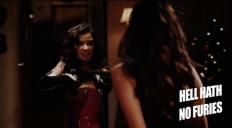
 HHNFuries.jpg2557 x 1410 - 935K
HHNFuries.jpg2557 x 1410 - 935K -
More stills from the shoot to illustrate the point - every light we used was diffused in some way - some a little; some a lot, but not one straight hard source. To not diffuse light when shooting digital is to invite failure. Suck all the color out of these and you get classic Noir.
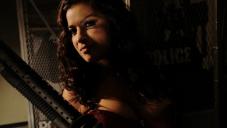
 Screen Shot 2017-06-28 at 4.41.54 PM.jpg1908 x 1074 - 1M
Screen Shot 2017-06-28 at 4.41.54 PM.jpg1908 x 1074 - 1M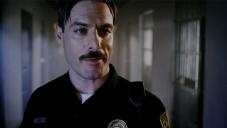
 Screen Shot 2017-06-28 at 4.37.39 PM.jpg1913 x 1081 - 1M
Screen Shot 2017-06-28 at 4.37.39 PM.jpg1913 x 1081 - 1M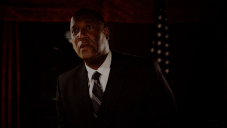
 Screen Shot 2017-06-28 at 4.34.44 PM.png1909 x 1077 - 1M
Screen Shot 2017-06-28 at 4.34.44 PM.png1909 x 1077 - 1M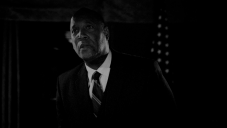
 Screen Shot 2017-06-28 at 4.34.44 PM_BW.jpg1909 x 1077 - 784K
Screen Shot 2017-06-28 at 4.34.44 PM_BW.jpg1909 x 1077 - 784K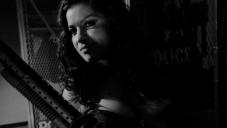
 Screen Shot 2017-06-28 at 4.41.54 PM _BW.jpg1908 x 1074 - 658K
Screen Shot 2017-06-28 at 4.41.54 PM _BW.jpg1908 x 1074 - 658K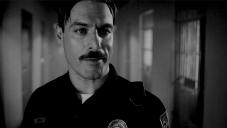
 Screen Shot 2017-06-28 at 4.37.39 PM_BW.jpg1913 x 1081 - 774K
Screen Shot 2017-06-28 at 4.37.39 PM_BW.jpg1913 x 1081 - 774K
Howdy, Stranger!
It looks like you're new here. If you want to get involved, click one of these buttons!
Categories
- Topics List23,990
- Blog5,725
- General and News1,353
- Hacks and Patches1,153
- ↳ Top Settings33
- ↳ Beginners256
- ↳ Archives402
- ↳ Hacks News and Development56
- Cameras2,366
- ↳ Panasonic995
- ↳ Canon118
- ↳ Sony156
- ↳ Nikon96
- ↳ Pentax and Samsung70
- ↳ Olympus and Fujifilm100
- ↳ Compacts and Camcorders300
- ↳ Smartphones for video97
- ↳ Pro Video Cameras191
- ↳ BlackMagic and other raw cameras116
- Skill1,960
- ↳ Business and distribution66
- ↳ Preparation, scripts and legal38
- ↳ Art149
- ↳ Import, Convert, Exporting291
- ↳ Editors191
- ↳ Effects and stunts115
- ↳ Color grading197
- ↳ Sound and Music280
- ↳ Lighting96
- ↳ Software and storage tips266
- Gear5,420
- ↳ Filters, Adapters, Matte boxes344
- ↳ Lenses1,582
- ↳ Follow focus and gears93
- ↳ Sound499
- ↳ Lighting gear314
- ↳ Camera movement230
- ↳ Gimbals and copters302
- ↳ Rigs and related stuff273
- ↳ Power solutions83
- ↳ Monitors and viewfinders340
- ↳ Tripods and fluid heads139
- ↳ Storage286
- ↳ Computers and studio gear560
- ↳ VR and 3D248
- Showcase1,859
- Marketplace2,834
- Offtopic1,320








